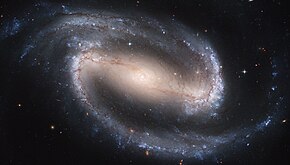
An elliptical galaxy is a type of galaxy with an approximately ellipsoidal shape and a smooth, nearly featureless image. They are one of the four main classes of galaxy described by Edwin Hubble in his Hubble sequence and 1936 work The Realm of the Nebulae, along with spiral and lenticular galaxies. Elliptical (E) galaxies are, together with lenticular galaxies (S0) with their large-scale disks, and ES galaxies with their intermediate scale disks, a subset of the "early-type" galaxy population.

Messier 59 or M59, also known as NGC 4621, is an elliptical galaxy in the equatorial constellation of Virgo. It is a member of the Virgo Cluster, with the nearest fellow member 8′ away and around 5 magnitudes fainter. The nearest cluster member of comparable brightness is the lenticular galaxy NGC 4638, which is around 17′ away. It and the angularly nearby elliptical galaxy Messier 60 were both discovered by Johann Gottfried Koehler in April 1779 when observing comet seeming close by. Charles Messier listed both in the Messier Catalogue about three days after Koehler's discovery.
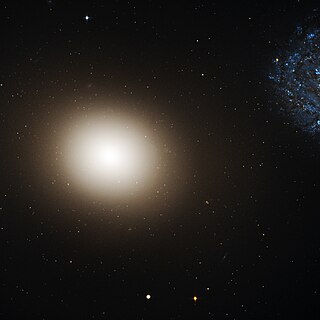
Messier 60 or M60, also known as NGC 4649, is an elliptical galaxy approximately 57 million light-years away in the equatorial constellation of Virgo. Together with NGC 4647, it forms a pair known as Arp 116. Messier 60 and nearby elliptical galaxy Messier 59 were discovered by Johann Gottfried Koehler in April 1779, observing a comet in the same part of the sky. Charles Messier added both to his catalogue about three days after this.
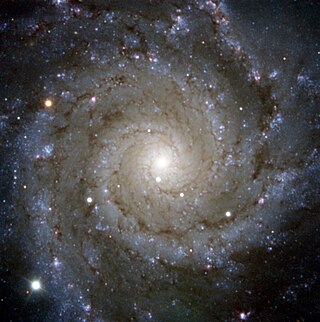
Messier 74 is a large spiral galaxy in the equatorial constellation Pisces. It is about 32 million light-years away from Earth. The galaxy contains two clearly defined spiral arms and is therefore used as an archetypal example of a grand design spiral galaxy. The galaxy's low surface brightness makes it the most difficult Messier object for amateur astronomers to observe. Its relatively large angular size and the galaxy's face-on orientation make it an ideal object for professional astronomers who want to study spiral arm structure and spiral density waves. It is estimated that M74 hosts about 100 billion stars.
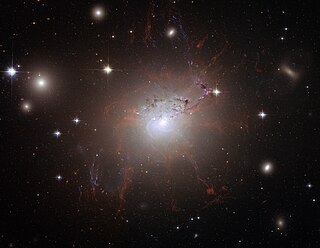
NGC 1275 is a type 1.5 Seyfert galaxy located around 237 million light-years away in the direction of the constellation Perseus. NGC 1275 is a member of the large Perseus Cluster of galaxies.

NGC 1566, sometimes known as the Spanish Dancer, is an intermediate spiral galaxy in the constellation Dorado, positioned about 3.5° to the south of the star Gamma Doradus. It was discovered on May 28, 1826 by Scottish astronomer James Dunlop. At 10th magnitude, it requires a telescope to view. The distance to this galaxy remains elusive, with measurements ranging from 6 Mpc up to 21 Mpc.

NGC 3593 is a lenticular galaxy located in the constellation Leo. It has a morphological classification of SA(s)0/a, which indicates it is a lenticular galaxy of the pure spiral type. Despite this, it has a large amount of hydrogen, both in its molecular and atomic (H) form. It is a starburst galaxy, which means it is forming new stars at a high rate. This is occurring in a band of gas surrounding the central nucleus. There is a single arm, which spirals outward from this ring. It is frequently but not consistently identified as a member of the Leo Triplet group.

NGC 1553 is a prototypical lenticular galaxy in the constellation Dorado. It is the second brightest member of the Dorado Group of galaxies. British astronomer John Herschel discovered NGC 1553 on December 5, 1834 using an 18.7 inch reflector.

NGC 2748 is a spiral galaxy in the northern circumpolar constellation of Camelopardalis, located at a distance of 61.3 megalight-years from the Milky Way. It was discovered September 2, 1828 by John Herschel. The morphological classification of SAbc indicates this is an unbarred spiral with moderate to loosely-wound spiral arms. It is a disk-like peculiar galaxy with a stellar shell that is rotating about the main galactic axis. This shell was most likely formed through the capture and disruption of a dwarf companion. The galactic nucleus likely contains a supermassive black hole with a mass of 4.4+3.5
−3.6×107 M☉, or 44 million times the mass of the Sun.
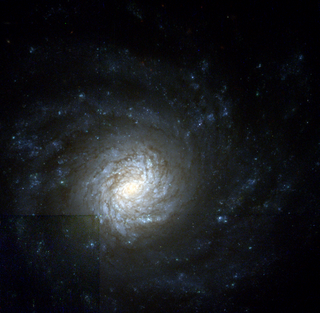
NGC 4041 is the New General Catalogue identifier for a spiral galaxy in the northern circumpolar constellation of Ursa Major. It is located an estimated 70 million light years from the Sun. The morphological classification of SA(rs)bc indicates this is a spiral galaxy the lacks a bar; the 'rs' means it has a weakly-formed ring structure, and the 'bc' indicates the spiral arms are moderately to loosely wound.

NGC 1407 is an elliptical galaxy in Eridanus. It is at a distance of 76 million light-years from Earth. It is the brightest galaxy in the NGC 1407 Group, part of the Eridanus Group, with NGC 1407 being its brightest member. NGC 1400, the second-brightest of the group lies 11.8 arcmin away.

NGC 4424 is a spiral galaxy located in the equatorial constellation of Virgo. It was discovered February 27, 1865 by German astronomer Heinrich Louis d'Arrest. This galaxy is located at a distance of 13.5 million light years and is receding with a heliocentric radial velocity of 442 km/s. It has a morphological class of SB(s)a, which normally indicates a spiral galaxy with a barred structure (SB), no inner ring feature (s), and tightly-wound spiral arms (a). The galactic plane is inclined at an angle of 62° to the line of sight from the Earth. It is a likely member of the Virgo Cluster of galaxies.

NGC 3941 is a barred lenticular galaxy located in the constellation Ursa Major. It is located at a distance of circa 40 million light years from Earth, which, given its apparent dimensions, means that NGC 3941 is about 40,000 light years across. It was discovered by William Herschel in 1787.
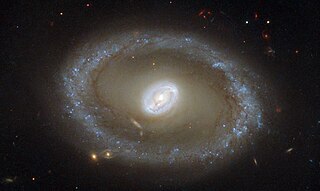
NGC 3081 is a barred lenticular ring galaxy in the constellation of Hydra. NGC 3081 is located about 85 million light-years away from Earth, which means, given its apparent dimensions, that NGC 3081 is approximately 60,000 light-years across. It is a type II Seyfert galaxy, characterised by its bright nucleus. It was discovered by William Herschel on 21 December 1786.

NGC 2336 is a barred spiral galaxy located in the constellation Camelopardalis. It is located at a distance of circa 100 million light years from Earth, which, given its apparent dimensions, means that NGC 2336 is about 200,000 light years across. It was discovered by Wilhelm Tempel in 1876.

NGC 7213 is a lenticular galaxy located in the constellation Grus. It is located at a distance of circa 70 million light-years from Earth, which, given its apparent dimensions, means that NGC 7213 is about 75,000 light-years across. It was discovered by John Herschel on September 30, 1834. It is an active galaxy with characteristics between a type I Seyfert galaxy and LINER.

NGC 6951 is a barred spiral galaxy located in the constellation Cepheus. It is located at a distance of about 75 million light-years from Earth, which, given its apparent dimensions, means that NGC 6951 is about 100,000 light-years across. It was discovered by Jérôme Eugène Coggia in 1877 and independently by Lewis Swift in 1878.
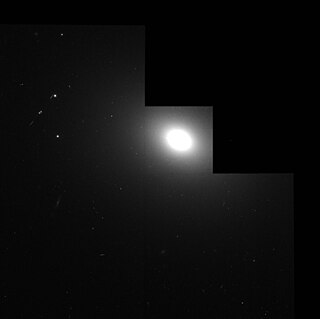
IC 1459 is an elliptical galaxy located in the constellation Grus. It is located at a distance of circa 85 million light-years from Earth, which, given its apparent dimensions, means that IC 1459 is about 130,000 light-years across. It was discovered by Edward Emerson Barnard in 1892.

NGC 3393 is a barred spiral galaxy located in the constellation Hydra. It is located at a distance of circa 180 million light-years from Earth, which, given its apparent dimensions, means that NGC 3393 is about 140,000 light-years across. It was discovered by John Herschel on March 24, 1835. It is a Type II Seyfert galaxy, known to host two supermassive black holes, which are the nearest known pair of supermassive black holes to Earth.
